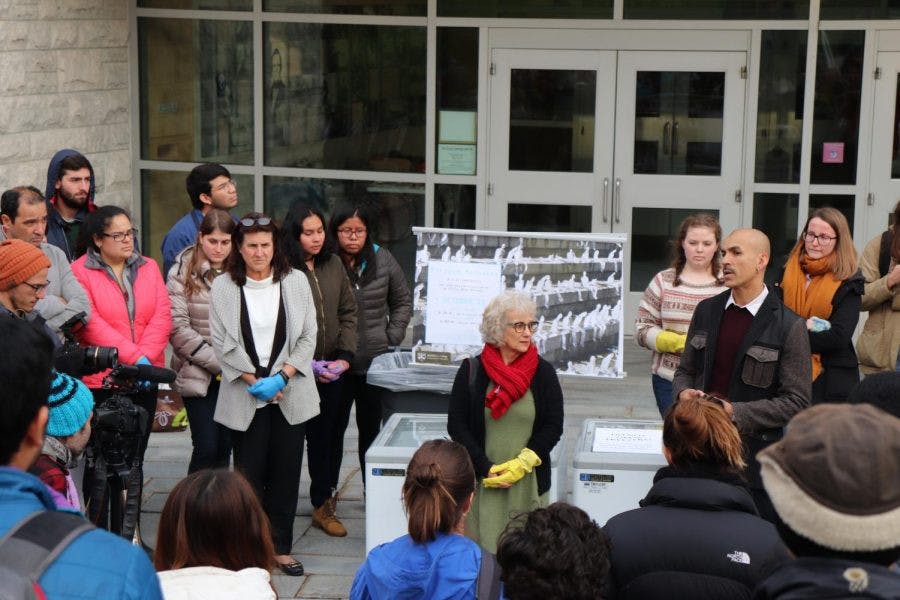“You are part of the performance,” artist Néle Azevedo told the crowd of students, professors, community members, children and a few dogs that gathered at the base of the Davis Library steps last Tuesday evening.
At the center of the crowd were two large freezers holding 400 eight-inch-tall figurines of men and women made of ice, the centerpieces of Azevedo’s renowned installment titled, “Minimum Monument: Art as Emergency.”
The piece, which involves ceremoniously “sitting” all of the figurines in line to then watch them gradually melt, is an environmentally-conscious performance event that serves as a visual metaphor for climate change.
Azevedo handed the first figurine to a little girl, commencing the display before crowds swarmed the artist and her team in order to take part. When first placed, the figurines held a crisp ghostly frost, sitting firmly on the steps where they were positioned. Once they began to melt, however, they slowly turned transparent and thinned ominously in unison. It was for this reason that Azevedo chose ice as her medium, describing it as poetic material for the installment.
Each figurine is made using a mold, after which Azevedo and her team hand-file and chip away at the ice to get the perfect shape. She described the process as grounding and meditative, emphasizing the importance of working with volunteers and members of the community that the piece is taking place in. It is this process that gives each figure an unmistakable human presence, making the piece both eerie and powerful as the frosty, featureless figures sit with their heads bent to watch the melted water slowly drip from their toes. Azevedo uses this facelessness to emphasize the unity of man, claiming, “I celebrate the anonymous figure” rather than any singularly powerful person. This is why the piece presents many small figures instead of one large one, she continued.
“I conceived this work subverting the characteristics of the official monuments,” she said. “It is an anti-monument.”

“You are part of the performance,” artist Néle Azevedo told the crowd of students, professors, community members, children and a few dogs that gathered at the base of the Davis Library steps last Tuesday evening.
Azevedo was invited to make her U.S. “Minimum Monument” debut by University of Vermont Professor Maria Woolson, who hosted the exhibit’s first showing on the school’s campus before coming to Middlebury. Prior to the Vermont installments, however, the monument had made a global name for itself. Azevedo has brought her art to countries throughout Europe, Asia and South America and frequently showcases the ice sculptures in Brazil, her home country. The largest was a display of approximately 5,000 figurines in Birmingham, UK in 2014.
Azevedo applied a broader context to her art by addressing the crowds about the threats facing the Amazon rainforest in her home country of Brazil.
Although the installation’s message is widely interpreted as a metaphor for the broad topic of climate change, the piece is meant to be somewhat interpretive, and it is not the first time “Minimum Monument” has been used as commentary on specific events.
Once, at a performance in Italy, it coincidentally took place in the midst of a protest on school privatization and was thus interpreted by the crowd as a metaphor for the children within Italy’s education system.
Again, though more intentionally this time, the piece was used in Brazil to protest plans for a construction of a dam that would uproot indigenous people from their homes. It was there that the monument took on its most blunt message as Azevedo molded one solitary female figurine out of her own blood to melt among the water. It was not until 2009 that the piece became distinctly known for its message on climate change, though Azevedo believes this interpretation to be paramount.
“Words are not enough,” said Azevedo on climate change.
Although the “Minimum Monument’s” figurines typically take 40 minutes to melt after they’re set up, the sunless mid-40s Vermont afternoon was not so obliging. The piece was still vaguely visible about four hours later on the Davis steps, though this became a part of its power.
Like climate change, the piece does not always present a clear and blatant progression. Instead, it gradually transformed over time.
The change was even more pronounced hours later as the melting and broken figures glowed in the fading twilight.

The piece is an environmentally-conscious performance event that serves as a visual metaphor for climate change.
Melting Art in a Melting World: Minimum Monument

MICHAEL BORENSTEIN & JOHN SCHURER/ THE MIDDLEBURY CAMPUS
MICHAEL BORENSTEIN & JOHN SCHURER/ THE MIDDLEBURY CAMPUS
Comments



